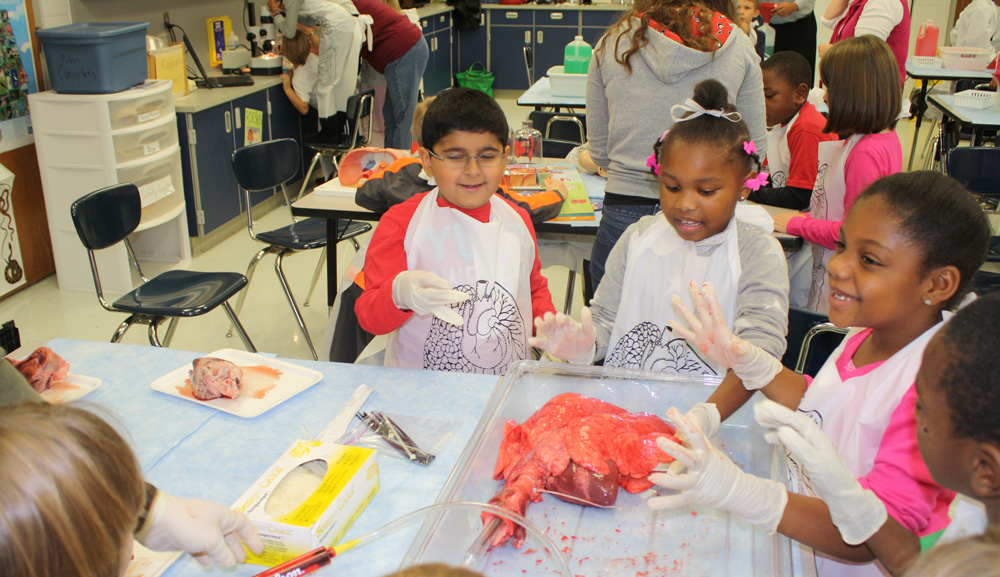“Touch it,” she says. “It’s really squishy!”
Physiology Understanding (PhUn) week, a national outreach program sponsored by the American Physiological Society and held each November, gives school children face-to-face interaction with working scientists and hands-on activities to learn more about their bodies’ cardiovascular and pulmonary systems. The School of Medicine’s Department of Cell, Developmental and Integrative Biology is spreading the PhUn over several days this month at two Birmingham-area schools.
“The idea is to get children interested in physiology and to engage school s with local universities to create a partnership between the two,” said Carmel McNicholas-Bevensee, Ph.D., an assistant professor of Cell, Developmental and Integrative Biology. “We set up different stations and let the students touch hearts and tissues while explaining those tissues’ roles in the body. These hands-on activities drive the point home better than simply watching a video.”
Students in grades K-6 have an opportunity to dress like a scientist, play with some medical equipment, build anatomical models of the chest and stomach, inflate pig lungs, look at lung and heart tissue under a microscope and test their own lung capacity with water displacement. The 40 PhUn volunteers –including faculty, postdoctoral fellows, graduate students and medical students—design the activities to be appropriate for the varying ages. Funding is provided by UAB’s Pulmonary and Injury Repair Center and the Center for Community Outreach Development.
This is the fourth year UAB has participated in PhUn Week in area schools. The late Dr. Dale Benos, Ph.D., the former chair of the Department of Physiology and Biophysics at UAB, encouraged a fellow in his lab to get involved with the outreach program. Bevensee took over the program three years ago, reaching a record 1,600 students last year and an estimated 1,450 this year through its programs at Deer Valley Elementary and Brock’s Gap Intermediate School this month and extended programs to other schools in the spring.
 “We have studied the human body, and having the UAB folks come in is a great tie-in to our curriculum,” said Elise Taylor, a first-grade teacher at Deer Valley Elementary. “We talk about our heart and lungs, how we use our bones and muscles and how our brains make our bodies work. Having these hands-on activities shows our students up close what these parts look like and what roles they play in their bodies.”
“We have studied the human body, and having the UAB folks come in is a great tie-in to our curriculum,” said Elise Taylor, a first-grade teacher at Deer Valley Elementary. “We talk about our heart and lungs, how we use our bones and muscles and how our brains make our bodies work. Having these hands-on activities shows our students up close what these parts look like and what roles they play in their bodies.” After the students have rotated through the different stations, volunteers talk to them about ways they can care for their own hearts, lungs and bodies with healthy food and exercise. The children are also shown the differences between healthy lungs and smoker’s lungs by seeing how the smoker’s lungs don’t inflate properly and are taught about the dangers of smoking.
“The kids have a great time and they look forward to it,” said Leslie Sulenski, a first-grade teacher at Deer Valley Elementary. “They leave the lab with a lot of knowledge that they would not have had and UAB presents them with a small bag of treats—a water bottle, a toy heart and tips on how to be healthy—that they can then take home and share with their parents.”
Bevensee said the outreach has potential long-term benefits for Birmingham, as well as for UAB.
“In line with (UAB) President Ray Watts’ dedication to the UAB mission of education, this program gives us the opportunity to bring our knowledge out into public schools and the community. We’re also encouraging children to take an interest in science,” Bevensee said. “In the long term, the earlier we can expose children to science and health sciences, the more likely they are to pursue science careers.”